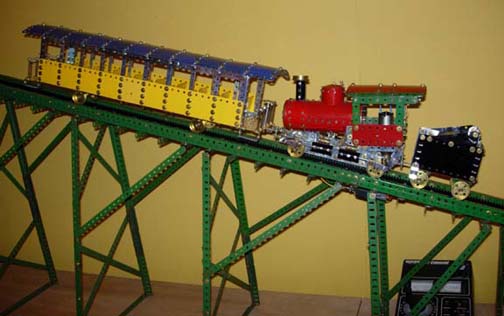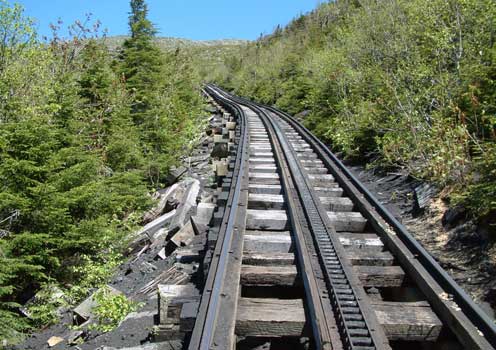- HOME
- VISIT
- ABOUT
- TOURS
- VISITOR FAQs
- LOCAL RESOURCES
- FAST FACTS
- MOAH HISTORY
- WILLIAMS HOUSE
- VICTORY GARDEN
- BOARD AND STAFF
- EXHIBITS
- CURRENT EXHIBIT
- PERMANENT EXHIBITS
- FUTURE EXHIBITS
- PAST EXHIBITS
- ARCHIVED EXHIBITS
- COLLECTION
- COLLECTION HISTORY
- DONATE TO THE COLLECTION
- SEARCH COLLECTION
- PROGRAMS & EVENTS
- CALENDAR
- ADULT PROGRAMS
- CHILDREN'S PROGRAMS
- ANNUAL EVENTS
- PAST EVENTS
- SPECIAL EVENTS
- GET INVOLVED
- MEMBERSHIP
- VOLUNTEER
- GIFT OPPORTUNITIES
- STAY CONNECTED
- EMAIL SIGNUP
- NEWSLETTERS
- PRESS
- Membership Response
Mount Washington Cog Railway
On July 3, 1869, a steam-powered train made its maiden journey to the top of 6,288-foot Mount Washington in New Hampshire. The Boston Transcript called the first mountain-climbing cog railway in the world "one of the greatest wonders of the time", and both the Mt. Washington Cog Railway and White Mountains tourism flourished. It is now a National Historic Engineering Landmark.
 With a maximum grade of 37% and an average grade of 25%, an ordinary train would not have sufficient traction to climb the steep slope. A cog railway has large cogs (gears) underneath the engine which engage a toothed rack strip in the middle of the track, providing the necessary force to propel the train.
With a maximum grade of 37% and an average grade of 25%, an ordinary train would not have sufficient traction to climb the steep slope. A cog railway has large cogs (gears) underneath the engine which engage a toothed rack strip in the middle of the track, providing the necessary force to propel the train.
This model, built mostly with Meccano parts made in Liverpool, England, is electrically powered from a hidden outside third rail on the far side. The trestle is 10 feet long and faithfully replicates the 25% average grade. The model contains about 7,000 parts and took about 150 hours to build.
How does the cog railway work?
A conventional railroad could never get a train and a load of people up Mt. Washington. The average grade is 25% with the steepest being 37.4%. That is to say, the track at the steepest point rises at the rate of 37 feet for every 100 feet it goes forward. Sylvester Marsh's design was a revolutionary solution to the problem.
 The 2.8 miles of track are built entirely on wooden trestle. On top of this wooden trestle, two light steel rails are laid in a method similar to standard railroad construction. Located in the center of the steel rails is a rack. The locomotives and cars are equipped with cogs (gears) that engage the rack. The cogs are driven by the steam pistons of the locomotive through a system of gears. Note how the boiler is mounted at a slant on the frame so as to be level while climbing the grade.
The 2.8 miles of track are built entirely on wooden trestle. On top of this wooden trestle, two light steel rails are laid in a method similar to standard railroad construction. Located in the center of the steel rails is a rack. The locomotives and cars are equipped with cogs (gears) that engage the rack. The cogs are driven by the steam pistons of the locomotive through a system of gears. Note how the boiler is mounted at a slant on the frame so as to be level while climbing the grade.
Four outer wheels support and guide the engine. The light engine is geared down to attain the power needed. For safety, it uses multiple braking systems.
It is interesting to note that the locomotive and passenger coach are not coupled to each other. The locomotive pushes the car up the track and remains in the same position for the trip down the mountain. The coach and the engine use separate braking systems.

This humble-looking Standard Vacuum Sweeper is the reason this Museum exists. In the early 1970s, accountant Frank Livermore spotted this sweeper in the corner of a local junk shop and, intrigued by its mechanical workings, Frank bought it on the spot. From that day on, he became a collector, and soon his Menlo Park home was bulging at the seams with his eclectic collection of antique mechanical and electrical devices.
Frank's friends joked that he should start a Museum of his own and, when one gave him a sign saying, Smithsonian West, Frank began to take the idea seriously. Frank and attorney Perry Moerdyke began the process of forming a registered non-profit Museum. In 1985 the Museum of American Heritage was incorporated. Frank's collection formed the nucleus of the Museum. In 1990 the Museum of American Heritage opened at its first location on Alma Street in Palo Alto and in 1997 MOAH was awarded tenancy of the City of Palo Alto's historic Williams House.
The Frank Livermore Trust was established to provide ongoing financial support for the care and maintenance of the collection.
Frank passed away in 2000, yet his curiosity and reverence for the spirit of innovation lives on in this Museum.
Today the collection boasts over 6,000 mechanical and electrical artifacts largely dating from the 1850s to the 1950s, which are housed in an offsite warehouse. Our artifacts are displayed in rotating exhibits at the Museum and are often loaned to other Museums and institutions for exhibit purposes.
Trademarks are the property of their owners
Join today! Membership dues help sustain MOAH. For more information and to download a Membership Form
LEARN MORE HERE
For questions and comments
Contact Us.
Mailing Address
PO Box 1731, Palo Alto, CA 94302
351 Homer Avenue
Palo Alto, California
p. 650.321.1004
e.




